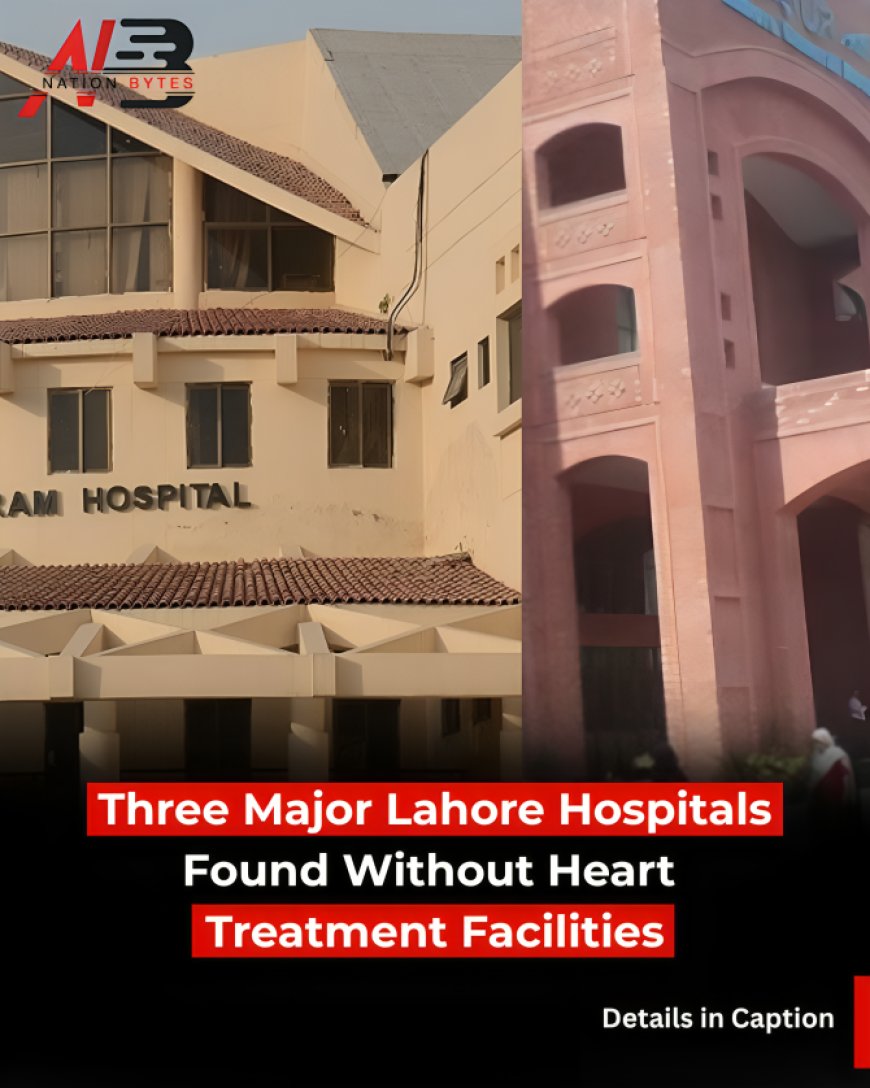3 Major Lahore Hospitals Found Without Heart Treatment Facilities
Three major Lahore hospitals lack full cardiology facilities, forcing heart patients into risky transfers. Experts urge urgent upgrades to save lives.

Heart patients in Lahore continue to face life-threatening challenges as three of the city’s leading public-sector teaching hospitals remain without fully functional cardiology services. do not have cardiology departments at all, while Sir Ganga Ram Hospital, despite having a basic cardiac unit, still lacks essential facilities such as angiography machines for diagnosing and treating coronary artery blockages.
Lahore’s Growing Burden of Heart Disease
Pakistan faces one of the highest rates of cardiovascular disease (CVD) in South Asia, with the World Health Organization (WHO) estimating that nearly one-third of all deaths in the country are caused by heart-related complications. Major urban centers like Lahore carry a disproportionate burden due to population density, rising lifestyle-related illnesses, and limited public healthcare infrastructure.
In such circumstances, the lack of cardiology departments in General Hospital and Services Hospital is viewed as a glaring gap in the city’s medical system. Experts say that given the patient load, every tertiary-care teaching hospital in Lahore should have a well-equipped cardiology unit, complete with angiography, angioplasty, cardiac surgery, and intensive care facilities.
Hospitals Without Proper Cardiology Units
-
General Hospital Lahore: Despite being one of the city’s busiest teaching hospitals, General Hospital does not have a dedicated cardiology department. Patients with suspected or confirmed heart disease are either shifted to Punjab Institute of Cardiology (PIC) or Mayo Hospital, often after dangerous delays.
-
Services Hospital Lahore: Similarly, Services Hospital lacks a cardiology wing altogether. Patients presenting with chest pain or heart failure are referred to other institutions, leaving them vulnerable to treatment delays.
-
Sir Ganga Ram Hospital: Although Ganga Ram Hospital has established a cardiac unit, it lacks angiography and interventional cardiology facilities. As a result, while some diagnostic and treatment options are available, the hospital cannot perform life-saving procedures such as stent placement during heart attacks.
Patients Forced Into Risky Hospital Transfers
Patients and their families say they are facing immense hardship because of these gaps. A lack of referral coordination between hospitals means that patients are often shuttled from one facility to another in search of appropriate treatment.
For a patient experiencing a heart attack, every minute matters. Medical research shows that delays in angioplasty or clot-removal procedures can dramatically increase the risk of death or long-term disability. Unfortunately, the absence of specialized facilities in these major hospitals forces many patients to rely on PIC, Mayo Hospital, or expensive private hospitals.
“My father was admitted to Services Hospital with severe chest pain, but doctors told us to take him to PIC immediately. We lost nearly two hours in transfer. This delay could have cost him his life,” said one patient’s son outside the hospital.
Experts Call for Urgent Policy Intervention
Healthcare experts believe the situation requires urgent intervention at the provincial government level. They recommend:
-
Establishing dedicated cardiology departments at General Hospital and Services Hospital.
-
Upgrading Sir Ganga Ram Hospital with modern angiography, angioplasty, and cardiac surgery facilities.
-
Introducing a referral and emergency transfer system between public hospitals to minimize delays.
-
Allocating sufficient funds in the Punjab health budget for cardiology infrastructure.
A senior cardiologist at PIC remarked:
“The patient load is far too high for a few hospitals to handle. PIC and Mayo are already overwhelmed. If other teaching hospitals like General, Services, and Ganga Ram do not step up with fully functional cardiology departments, we will continue to see unnecessary patient deaths.”
At present, the burden of cardiac emergencies in Lahore largely falls on three institutions:
-
Punjab Institute of Cardiology (PIC) – the city’s premier cardiology facility, already stretched far beyond its capacity.
-
Mayo Hospital – providing cardiac surgery and emergency cardiology services but struggling with overcrowding.
-
Jinnah Hospital – catering to a growing number of cardiac patients due to the lack of alternatives.
The over-reliance on a limited number of hospitals creates bottlenecks, forcing patients into long waiting times and delayed procedures.
Government’s Role and Responsibility
Civil society groups and patient advocates argue that the government has a constitutional responsibility to provide adequate healthcare, especially for life-threatening diseases like heart conditions. They note that billions are spent annually on infrastructure projects, while basic hospital services remain underfunded.
With heart disease ranking as Pakistan’s leading cause of mortality, experts warn that ignoring cardiology facilities in major hospitals could have devastating consequences for public health.
The lack of proper cardiology facilities in General Hospital, Services Hospital, and Sir Ganga Ram Hospital represents a critical gap in Lahore’s healthcare system. Thousands of patients continue to suffer, forced into risky hospital transfers and delayed treatments, while existing institutions like PIC and Mayo Hospital remain overwhelmed.

 Israr Ahmed
Israr Ahmed